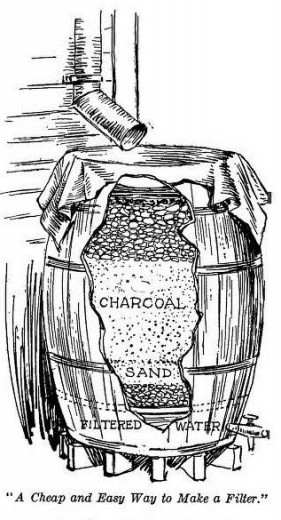Water was a topic of conversation wherever we went during our boiling, broiling, and blistering 2022 summer here in the Missouri Ozarks. Creeks and ponds dried up (some never recovered), and the water table fell, causing some homeowners to lower their good pumps or even dig deeper wells.

Many folks exchanged memories of barrels of rain, cisterns, hand pumps, and drawing water as a kid with a good bucket, usually on the farm of grandpa and grandma. Some said they would never want to rely on those old methods of having water again. Yet, they at least understood how it came about.
It seems like in the last 50 years or so we have lost a lot of practical information because we thought we would never need it again. We are now struggling to relearn the basic know-how.
A 1909 tattered book I gladly purchased for $8 in a thrift store, 4-inch thick, shows, among countless thousands of other daily skills, how to make homemade water filters. The instructions in “Household Discoveries and Mrs. Curtis’s Cookbook” are quite basic as everyone had a rain barrel back then and presumably knew how to clean the water.
Today, 104 years later, I am glad that the writers had the foresight to retain their wisdom for us, and pointed out that rainwater gathered from a roof in barrels is a requirement in some areas, but is also better for laundry and “often more wholesome for drinking purposes than hard water.”
The “wholesome” statement also refers to plants. During our dry spell of 6 weeks (not a drop of rain), I found that I could only keep my vegetables alive with the garden hose – until our well, too, started sucking air. In reality, the pitiful plants of potatoes, tomatoes, and beans looked petrified, like fading plastic decorations. Then the plants sprung miraculously to life after a 2-hour rain shower-vivid, green and THRIVING. I, did, too.
I delighted myself with a 425-gallon water tank at the beginning of June last year, so I could water with nutritious rainwater though it was August before any amount of water was in the tank. When the relentless rains eventually stopped momentarily overhead, I was out in it with my 2-gallon watering bucket, running and slicing the water like a madman onto our neglected trees high up the hill.
100-Year-Old Instructions
Naturally, rainwater is better left unfiltered for planting. But the vintage book says the following instructions include a cheap and simple way to make a filter as good as a patent filter costing 10 times as much for household use:
“Take a new vinegar barrel or an oak tub that has never been used, either a full cask or half size. Stand it on end raised on brick or stone from the ground. Insert a faucet near the bottom. Make a tight false bottom 3 or 4 inches from the bottom of the cask. Perforate this with small gimlet holes, and cover it with a piece of clean white canvas.
“Place on this false bottom a layer of clean pebbles 3 or 4 inches in thickness; next, a layer of clean washed sand and gravel; then coarsely granulated charcoal about the size of small peas. Charcoal made from hard maple is the best.
“After putting in a half bushel or so, pound it down firmly. Then put in more until the tub is filled within 1 foot of the top. Add a 3-inch layer of pebbles, and throw over the top a piece of canvas as a strainer. This canvas strainer can be removed and washed occasionally and the cask can be dumped out, pebbles cleansed and charcoal renewed every spring and fall, or once a year may be sufficient.
“This filter may be set in the cellar and used only for drinking water. Or it may be used in times of drought for filtering stagnant water, which would otherwise be unpalatable, for the use of stock. This also makes a good cider filter for the purpose of making vinegar. The cider should first be passed through cheesecloth to remove all coarser particles.
“Or a small cheap filter may be made from a flower pot. A fine sponge may be inserted in the hole and the pot filled about as directed for the above filter. It may be placed in the top of a jar, which will receive the filtered water.”


